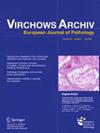Ekaterina Bazyleva, Lotte E van der Meeren, Mirthe H Schoots, Linda M Ernst, T Yee Khong, Neil J Sebire, Paul Seegers, Sanne J Gordijn
求助PDF
{"title":"阿姆斯特丹标准和超越:一个标准化的结构化报告(SSR)工具的发展,用于诊断胎盘病理。","authors":"Ekaterina Bazyleva, Lotte E van der Meeren, Mirthe H Schoots, Linda M Ernst, T Yee Khong, Neil J Sebire, Paul Seegers, Sanne J Gordijn","doi":"10.1007/s00428-025-04143-0","DOIUrl":null,"url":null,"abstract":"<p><p>The lack of standardized reporting in placental pathology limits research scalability and clinical application despite consensus-based criteria like the Amsterdam Criteria. This study presents the development and implementation of a comprehensive Standardized Structured Reporting (SSR) tool for placental pathology. Utilizing the LogicNets© platform, the tool incorporates the Amsterdam Criteria, Freedman placental phenotype classification system, and consensus recommendations on placental examination. Development involved collaboration with placental pathology experts, literature review, and iterative feedback from pathologists to address reporting inconsistencies and ensure practicality. The SSR tool integrates evidence-based standards for examining and phenotyping the placenta, including structured gross and microscopic analyses. It introduces control mechanisms for severity grading and phenotype assignment, enabling precise assessment of placental lesions, even in multiple births. Organized into sections-Demographics, Macroscopy, Microscopy, and Group and Phenotype-it efficiently records and analyzes data. Additional functionalities include automated calculations of gross placental features, built-in controls, and versatile documentation of microscopic observations. The tool is designed for seamless integration into clinical workflows. Implementing the SSR tool could enhance placental pathology reporting quality, completeness, and consistency, facilitating large-scale analyses. Discrete data capture enables robust research, potentially improving the clinical utility and understanding of placenta-mediated diseases. However, further validation is required before widespread adoption. Embracing SSR could standardize placental examination, improve clinical interpretation, and advance research in placental pathology for enhanced utility in both research and clinical care.</p>","PeriodicalId":23514,"journal":{"name":"Virchows Archiv","volume":" ","pages":""},"PeriodicalIF":3.1000,"publicationDate":"2025-06-18","publicationTypes":"Journal Article","fieldsOfStudy":null,"isOpenAccess":false,"openAccessPdf":"","citationCount":"0","resultStr":"{\"title\":\"The Amsterdam Criteria and beyond: development of a Standardized Structured Reporting (SSR) tool for diagnosis of placental pathology.\",\"authors\":\"Ekaterina Bazyleva, Lotte E van der Meeren, Mirthe H Schoots, Linda M Ernst, T Yee Khong, Neil J Sebire, Paul Seegers, Sanne J Gordijn\",\"doi\":\"10.1007/s00428-025-04143-0\",\"DOIUrl\":null,\"url\":null,\"abstract\":\"<p><p>The lack of standardized reporting in placental pathology limits research scalability and clinical application despite consensus-based criteria like the Amsterdam Criteria. This study presents the development and implementation of a comprehensive Standardized Structured Reporting (SSR) tool for placental pathology. Utilizing the LogicNets© platform, the tool incorporates the Amsterdam Criteria, Freedman placental phenotype classification system, and consensus recommendations on placental examination. Development involved collaboration with placental pathology experts, literature review, and iterative feedback from pathologists to address reporting inconsistencies and ensure practicality. The SSR tool integrates evidence-based standards for examining and phenotyping the placenta, including structured gross and microscopic analyses. It introduces control mechanisms for severity grading and phenotype assignment, enabling precise assessment of placental lesions, even in multiple births. Organized into sections-Demographics, Macroscopy, Microscopy, and Group and Phenotype-it efficiently records and analyzes data. Additional functionalities include automated calculations of gross placental features, built-in controls, and versatile documentation of microscopic observations. The tool is designed for seamless integration into clinical workflows. Implementing the SSR tool could enhance placental pathology reporting quality, completeness, and consistency, facilitating large-scale analyses. Discrete data capture enables robust research, potentially improving the clinical utility and understanding of placenta-mediated diseases. However, further validation is required before widespread adoption. Embracing SSR could standardize placental examination, improve clinical interpretation, and advance research in placental pathology for enhanced utility in both research and clinical care.</p>\",\"PeriodicalId\":23514,\"journal\":{\"name\":\"Virchows Archiv\",\"volume\":\" \",\"pages\":\"\"},\"PeriodicalIF\":3.1000,\"publicationDate\":\"2025-06-18\",\"publicationTypes\":\"Journal Article\",\"fieldsOfStudy\":null,\"isOpenAccess\":false,\"openAccessPdf\":\"\",\"citationCount\":\"0\",\"resultStr\":null,\"platform\":\"Semanticscholar\",\"paperid\":null,\"PeriodicalName\":\"Virchows Archiv\",\"FirstCategoryId\":\"3\",\"ListUrlMain\":\"https://doi.org/10.1007/s00428-025-04143-0\",\"RegionNum\":3,\"RegionCategory\":\"医学\",\"ArticlePicture\":[],\"TitleCN\":null,\"AbstractTextCN\":null,\"PMCID\":null,\"EPubDate\":\"\",\"PubModel\":\"\",\"JCR\":\"Q1\",\"JCRName\":\"PATHOLOGY\",\"Score\":null,\"Total\":0}","platform":"Semanticscholar","paperid":null,"PeriodicalName":"Virchows Archiv","FirstCategoryId":"3","ListUrlMain":"https://doi.org/10.1007/s00428-025-04143-0","RegionNum":3,"RegionCategory":"医学","ArticlePicture":[],"TitleCN":null,"AbstractTextCN":null,"PMCID":null,"EPubDate":"","PubModel":"","JCR":"Q1","JCRName":"PATHOLOGY","Score":null,"Total":0}
引用次数: 0
引用
批量引用

 求助内容:
求助内容: 应助结果提醒方式:
应助结果提醒方式:


